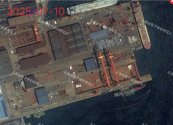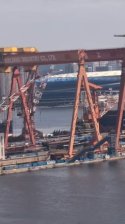In their recent stream, Yankee and Ayi discussed a hypothetical Type 077 medium sized aircraft carrier at length. Their comments are based entirely on personal analysis and not on any insider information. Essentially, even if a Type 077 is never built, the "mental gymnastics" around it are still meaningful and worthwhile.
- The development of larger gas turbines isn’t just "for fun", but rather it opens up new operational possibilities worth exploring. And it's incorrect to say that only steam turbines are suitable for large carriers; gas turbines are viable as well.
- In certain air wing configurations, an angled flight deck isn't strictly necessary. For example, if the air wing consists solely of J-35s and one type of UAV, a straight-deck carrier could still be effective. It's important to avoid rigid thinking, that the lack of an angled flight deck doesn't gatekeep the ship from being a real aircraft carrier.
- There's also export potential here. If a country is interested in a hypothetical J-35E (not J-35AE), such a small STOBAR carrier, even one without an angled deck, could be very sufficient.
- For the PLAN's surface combatants, having consistent and reliable aviation cover would be a significant advantage.
- Deploying a larger carrier to a region like the Middle East, even a carrier like the Liaoning or Shandong, would carry heavy political implications and is actually far from straightforward. A Type 077 would face far fewer constraints.
- Strategically, there are also clear advantages. Given China's limited carrier fleet in the near term, deploying a Type 077 for distant missions would be far less risky than sending a Fujian or larger vessel, especially if conflict were to erupt in the WESTPAC. A smaller carrier also imposes fewer constraints on shipyard selection and production timelines.
- You can think of the "Type 077" as a kind of "multirole aircraft carrier", in that it is efficient at handling "lower leveled" missions, while still being competitive in the higher end missions.
- The PLAN is currently between major shipbuilding phases. The teams behind the 075 and 076 need a new challenge to explore. The 076 remains highly experimental and far from perfect. Building a second one may not be the optimal next step, as opposed to having it serve as an intermediate step for the next generation of PLAN ships.



